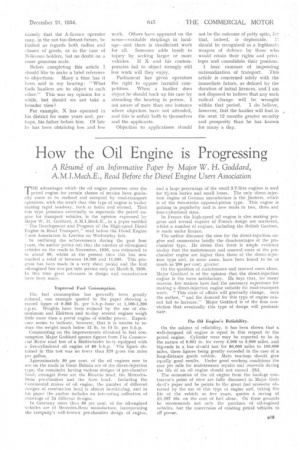How the Oil Engine is Progressing
Page 33

If you've noticed an error in this article please click here to report it so we can fix it.
A Resurn of an Informative Paper by Major W. H. Goddard, A.M.I.Mech.E., Read Before the Diesel Engine Users Association TEE advantages which the oil engine possesses over the petrol engine for certain classes of service have gradually come to he realized and accepted byroad-transport operators, with the result that this type of engine is to-day making rapid headway, both at home and abroad. That this type promises eventually to supersede the petrol engine for transport vehicles, is the opinion expressed by Major W. H. Goddard, A.M.I,Mech,E., in a paper entitled " The Development and Progress of the High-speed Diesel Engine in Road Transport," read before the Diesel Engine Lsers Association in London on Wednesday last.
In outlining the achievements during the past four years, the author points out that the number of oil-engined vehicles on the roads in November, 1930, was estimated to be about 90, whilst at the present time this has now reached a total of between 10,000 and 11,000. This progress has been made in a very short period and the first oil-engined bus was put into service only on March 9, 1930. ln this time great advances in design and manufacture have been made,
Tkinproved Fuel Consumption.
The, fuel consumption has generally been greatly reduced, one example quoted in the paper showing a record figure of 0.368 lb. per b.h.p.-hour at 1,100-1,200 r.p.m. Weights have been reduced by the use of aluminimum and Elektron and to-day several engines weigh little more than a petrol engine of similar power. Experience seems to indicate, however, that it is unwise to reduce the weight much below 12 lb. to 13 lb. per b.h.p.
Commenting on the improvements obtained in fuel consumption Major Goddard quotes figures from The Commercial Motor road test of a Multiwheeler lory equipped with a five-cylindered oil engine of 80 b.h.p. The figure obtained in this test was no fewer than 320 gross ton miles per gallon.
Approximately 50 per cent, of the oil engines now in use on the roads in Great Britain are of the direct-injection type, the reinaindei having various designs of pre-chamber head; amongst these are the Ricardo head, the MercedesBenz pre-chamber and the Acro head. Including the Continental makes of oil engine, the number of different designs of .comhus:ion head is almost bewildering, and in his paper the author includes an in teTcsting collection of drawingsof 24 different designs.
In Germany More than 50 per cent, of the oil-engined vehicles are Of Mercedes-Benz 'manufacture, incorporating the company's well-known pre-chamber design of engine,
and a large percentage of the small 3.7-litre engines is used for 2i-ton lorries and small buses. The only direct-injeetion engine of German manufacture is the Junkers, which is of the two-stroke opposed-piston type. This engine is gaining in popularity and is now made in two, three and four-cylindered sizes.
In France the high-speed oil engine is also making progress and several engines of 'French design are marketed, whilst a number of engines, including the British Gardner, is made under licence.
The author discusses the case for the direct-injection engine and enumerates briefly the disadvantages of the pre. chamber type. He state's that there is ample evidence to-day that the maintenance and renewal costs of the pee. chamberengine are higher than those of the direct-injec*ion type and, in some cases, have been found to be as much as 200 per cent. greater.
On the question of maintenance and renewal costs alone, Major Goddard is of the opinion that the direct-injection engine is the more satisfactory. He Says that, for many reasons, few makers have had the necessary experience for making a direct-injection engine suitable for road-transport work. "This state of affairs will gradually change, says the author, "and the demand for this type of engine cannot fail to increase." Major Goddard is of the firm conviction that eventually this type of design will predominate.
rho Oa Engine's Reliability.
On the subject of reliability, it has been shown that a well-designed oil engine is equal in this respect to, the petrol engine. Cylinder wear may be expected to be in. the nature of 0.001 in. for every 4,000 to 5,000 miles, and big-ends in a bus should last for 80,000 miles to 100,000 miles, these figures being greatly exceeded in the case of a long-distance goods vehicle. Main bearings should give equally good results, Under good working conditions the cost per mile for maintenance repairs and renewals during the life of an oil engine should not exceed .25d.
The economies of the oil engine from the haulage contractor's ,point of view are fully discussed in Major Godda.rit's paper and he points to the great fuel economy obtained by the use of this type of engine and, taking the life of the vehicle as five years, quotes a saving of £1,267 Ns. on the cost of fuel alone. On these grounds he recommends not only the purchase of oil-engined vehicles, hut 'the conversion of existing petrol vehicles to oft powvr.




























































































